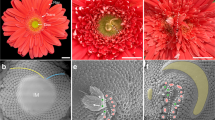Abstract
The survival of higher plants is highly dependent upon the phloem path linking assimilate sources and sinks. In an individual plant the elongation, capacity and function of this path have to be finely adjusted to internal and environmental conditions. This means, at the cellular level, that the initiation of new sieve elements, the timing of their differentiation and the start of their function are subject to the changing requirements of the surrounding tissue.
Access this chapter
Tax calculation will be finalised at checkout
Purchases are for personal use only
Preview
Unable to display preview. Download preview PDF.
Similar content being viewed by others
References
Aloni R, Plotkin T (1985) Wound-induced and naturally occurring regenerative differentiation of xylem in Zea mays L. Planta 163: 126–132.
Behnke H-D (1974) Comparative ultrastructural investigations of angiosperm sieve elements: aspects of the origin and early development of P-protein. Z Pflanzenphysiol 74: 22–34.
Behnke H-D (1981) Sieve-element characters. Nord J Bot 1: 381–400.
Behnke H-D, Pop L (1981) Sieve-element plastids and crystalline P(hloem)-protein in Leguminosae: micromorphological characters as an aid to the circumscription of the family and subfamilies. In: Polhill RM, Raven PH (eds) Advances in legume systematics. Academic Press, New York London, pp 707–715.
Behnke H-D, Schulz A (1980) Fine structure, pattern of division, and course of wound phloem in Coleus blumei. Planta 150: 357–365.
Behnke H-D, Schulz A (1983) The development of specific sieve-element plastids in wound phloem of Coleus blumei (S-type) and Pisum sativum (P-type), regenerated from amyloplast-containing parenchyma cells. Protoplasma 144: 125–132.
Behnke H-D, Sukkri B (1971) Anastomoses in the internode of Dioscorea: their frequency, structure, and function. Z Pflanzenphysiol 66: 82–92.
Benayoun J, Aloni R, Sachs T (1975) Regeneration around wounds and the control of vascular differentiation. Ann Bot (London) 39: 447–457.
Bouck GB, Cronshaw J (1965) The fine structure of differentiating sieve tube elements. J Cell Biol 25: 79–95.
Esau K (1965) Plant anatomy, 2nd edn. John Wiley & Sons, New York London Sidney.
Esau K (1969) The phloem. In: Zimmermann W, Ozenda P, Wulff HD (eds) Encyclopedia of plant anatomy, vol 5, pt 2. Borntraeger, Berlin Stuttgart, 505 pp.
Esau K (1978) Developmental features of the primary phloem in Phaseolus vulgaris L. Ann Bot (London) 42:1–13.
Eschrich W (1953) Beiträge zur Kenntnis der Wundsiebröhrenentwicklung bei Impatiens holsti. Planta 43: 37–74.
Hardham AR, McCully ME (1982a) Reprogramming of cells following wounding in pea (Pisum sativum L.) roots. I. Cell division and differentiation of new vascular elements. Protoplasma 112:143–151.
Hardham AR, McCully ME (1982b) Reprogramming of cells following wounding in pea (Pisum sativum L.) roots. II. The effects of caffeine and colchicine on the development of new vascular elements. Protoplasma 112: 152–166.
Hughes JE, Gunning BES (1980) Glutaraldehyde-induced deposition of callose. Can J Bot 58:250–258.
Kollmann R, Dörr I, Schulz A, Behnke H-D (1983) Funktionelle Differenzierung der Assimilatleitbahnen. Ber Dtsch Bot Ges 96: 117–132.
Lawton DM (1978) P-protein crystals do not disperse in uninjured sieve elements in roots of runner bean (Phaseolus multiflorus) fixed with glutaraldehyde. Ann Bot (London) 42:353–361.
Lehmann J (1973) Zur Lokalisierung der Dehydrogenasen des Energiestoffwechsels im Phloem von Cucurbita pepo L. Planta 111: 187–198.
Neeff F (1914) Über Zellumlagerung. Ein Beitrag zur experimentellen Anatomie. Z Bot 6:465–547.
Robbertse PJ, McCully ME (1979) Regeneration of vascular tissue in wounded pea roots. Planta 145:167–173.
Schulz A (1979) Über Feinbau und Entwicklung von Wundphloem bei Coleus blumei (Lamiaceae). Staatsexamensarbeit, Fak Biol, Univ Heidelberg.
Schulz A (1984) Licht— und elektronenmikroskopische Untersuchungen zur Entwicklung und Funktion von Wundphloem bei Pisum sativum L. (Fabaceae). Thesis, Ruprecht-Karls-Univ, Heidelberg.
Schulz A (1986a) Wound phloem in transition to bundle phloem in primary roots of Pisum sativum L. I. Development of bundle-leaving wound-sieve tubes. Protoplasma 130: 12–26.
Schulz A (1986b) Wound phloem in transition to bundle phloem in primary roots of Pisum sativum L. II. The plasmatic contact between wound-sieve tubes and regular phloem. Protoplasma 130: 27–40.
Schulz A (1986c) Die Entwicklung von Wundleitbündeln in der Wurzelrinde von Pisum sativum L. In: Botanikertagung Hamburg, Abstracts, p 184.
Schulz A (1987) Sieve-element differentiation and fluoresceine translocation in wound-phloem of pea roots after complete severance of the stele. Planta 170: 289–299.
Schulz A (1988) Vascular differentiation in the root cortex of peas: premitotic stages of cytoplasmic reactivation. Protoplasma 143: 176–187.
von Kaan-Albest A (1934) Anatomische und physiologische Untersuchungen über die Entstehung von Siebröhrenverbindungen. Z Bot 27: 1–94.
Wark MC, Chambers TC (1965) Fine structure of the phloem of Pisum sativum. I. The sieve element ontogeny. Aust J Bot 13:171–183.
Zee S-Y (1968) Ontogeny of cambium and phloem in the epicotyl of Pisum sativum. Aust J Bot 16: 419–426.
Zee S-Y, Chambers TC (1968) Fine structure of the primary root phloem of Pisum. Aust J Bot 16: 37–47.
Zee S-Y, Chambers TC (1969) Development of the secondary phloem of the primary root of Pisum. Aust J Bot 17: 119–214.
Editor information
Editors and Affiliations
Rights and permissions
Copyright information
© 1990 Springer-Verlag Berlin Heidelberg
About this chapter
Cite this chapter
Schulz, A. (1990). Wound-Sieve Elements. In: Behnke, HD., Sjolund, R.D. (eds) Sieve Elements. Springer, Berlin, Heidelberg. https://doi.org/10.1007/978-3-642-74445-7_10
Download citation
DOI: https://doi.org/10.1007/978-3-642-74445-7_10
Publisher Name: Springer, Berlin, Heidelberg
Print ISBN: 978-3-642-74447-1
Online ISBN: 978-3-642-74445-7
eBook Packages: Springer Book Archive




